#edit: fixed the Greek text
Text
Being multilingual is just *tries to open the emojis* *accidentally hits the switch keyboard* *αρχίζει να πληκτρολογεί στα ελληνικά* *desperately trying to switch back to English* * sélectionne le clavier français*
#multilingual#multilinguism#no one @ me about the grammar#my grammar in Greek and French literally suck#i just know the basic stuff#i know them because they’re household languages#Greek immigrant#French#québécois#québec#child of immigrants#edit: fixed the Greek text#again Greek is a household language I rarely use outside of my family#so my grammar and vocabulary suck
5K notes
·
View notes
Note
OK I’m asking. Do you have any idea of the name of the painting on the blog cover the one where the guys looking through to another reality/ dimension?
I'm glad you asked! The cover photo on my blog is called 'The Flammarion Engraving.' Though, there is an interesting backstory to it if you'd like to know more about it.
The only thing known about the artwork is that it is from Camille Flammarion’s (1842–1925) book titled: 'L’atmosphère: météorologie populaire', (1888) which in English translates to: 'The Atmosphere: Popular Meteorology'.
The artwork is actually not a painting, but a woodwork carving used with a Burin tool as shown in the diagram below:

|Mid–17th century French Burin 'Cold Chisel' later to be called an 'engraver' in English. Source: Wikipedia
What is most interesting about the Artwork is that the origin of the Artist is still unknown and yet to be determined. It is speculated that Flammarion himself did the carving, however– the image depicts different image characteristics from different historical periods; some art Historians, such as Erwin Panofsky, date the engraving to the 16th century; while others, specifically Ernst Gombrich, date it to the late 19th century era.
According to historyofinformation.com:
"In Flammarion's L'atmosphère: météorologie populaire, the image refers to the text on the facing page (p. 163), which also clarifies the author's intent in using it as an illustration:"
"Whether the sky be clear or cloudy, it always seems to us to have the shape of an elliptic arch; far from having the form of a circular arch, it always seems flattened and depressed above our heads, and gradually to become farther removed toward the horizon.
Our ancestors imagined that this blue vault was really what the eye would lead them to believe it to be; but, as Voltaire remarks, this is about as reasonable as if a silk-worm took his web for the limits of the universe. The Greek astronomers represented it as formed of a solid crystal substance; and so recently as Copernicus, a large number of astronomers thought it was as solid as plate-glass. The Latin poets placed the divinities of Olympus and the stately mythological court upon this vault, above the planets and the fixed stars.
Previous to the knowledge that the earth was moving in space, and that space is everywhere, theologians had installed the Trinity in the empyrean, the glorified body of Jesus, that of the Virgin Mary, the angelic hierarchy, the saints, and all the heavenly host.... A naïve missionary of the Middle Ages even tells us that, in one of his voyages in search of the terrestrial paradise, he reached the horizon where the earth and the heavens met, and that he discovered a certain point where they were not joined together, and where, by stooping his shoulders, he passed under the roof of the heavens..."
"The same paragraph had already appeared, without the accompanying engraving, in an earlier edition of the text published under the title of L'atmosphère: description des grands phénomènes de la Nature ("The Atmosphere: Description of the Great Phenomena of Nature," 1872). The correspondence between the text and the illustration is so close that one would appear to be based on the other. Had Flammarion known of the engraving in 1872, it seems unlikely that he would have left it out of that year's edition, which was already heavily illustrated. The more probable conclusion therefore is that Flammarion commissioned the engraving specifically to illustrate this particular text, though this has not been ascertained conclusively." —historyofinformation.com
I provided the links and sources below if you'd like to read more about it!
|Sources:
https://en.m.wikipedia.org/wiki/Flammarion_engraving#:~:text=Although%20sometimes%20referred%20to%20as,occur%20until%20after%20Flammarion's%20death.
https://projects.iq.harvard.edu/eswg/event/stefano-gattei-original-fak1e-solving-mystery-flammarions-engraving
https://galileo.ou.edu/exhibits/atmosphere-popular-meteorology
https://publicdomainreview.org/collection/flammarion-engraving/
#occult#wisdom#mysticism#esoteric#alchemy#spirituality#hermeticism#ancient philosophy#ancient wisdom#philosophy#western esotericism#writers and poets#mystical#ancient history#forgotten history#forbidden knowledge#symbolism#self development#as above so below#spirit#words#liberation#nonduality#mystery#look within#renaissance#enlightenment#spiritual enlightment#samsara#eastern philosophy
9 notes
·
View notes
Text
Cyberpunk 2077: Johnny is Pistis Sophia
Disclaimer: I wrote my analysis based on Book I. XI Volume of Nag Hammadi Studies, edited by Schmidt, C. and translated by Macdermot, V. in 1978. I'm not a Gnostic and I don't have credentials in this matter. For terminology I've placed links to outside sources.
Basics first.
Pistis Sophia, aside of being an abandoned hotel in Cyberpunk 2077, is a Gnostic text, supposedly written between 3rd and 4rd centuries AD. It's divided into four books, with only first two directly following each other, and academics are convinced the whole content comes from multiple sources.
The text's title is also a name of feminine Aeon who ought to form a pair with another to become Syzygy (Syzygoi), which in Greek means "conjunction, yoked together"…
And that's where plot of Cyberpunk comes to play.
Pistis Sophia fell into disgrace after or simultaneously being deceived by Authades, masculine Aeon, who grew jealous of Sophia's will to worship the Light rather than continuing the known ways of Aeons. Authades' doings led Sophia into realm of Chaos, in hopes she loses power. How? By manipulating Sophia to transform into Syzygy on her own. As you can probably guess, it went wrong. Horribly wrong. Luckily, someone heard Sophia's call and rescued her.
Now let's look at our rockerboy, Johnny Silverhand. From TTRPG and 2077's lore we know he deserted from military and spent whole three months in the hotel Pistis Sophia, eyes fixed on a fan and scruffy ceiling. Robert John Linder back then, he named himself Johnny Silverhand and swore to be someone new. Except he, just like Sophia, was completely alone at this very moment. It's no secret we humans are the worst judges when it comes to ourselves, our existence is dependable on others. Johnny's not an exception.
Therefore, all Silverhand's royal fuck-ups are no secret. His life, even post mortem, is c-h-a-o-t-i-c with capital C.

Aeon I mentioned before, Pistis Sophia, received help from — better buckle up, chooms — Jesus Christ. The catch is: she had no idea it was him. Sophia prayed all the time* for help to the Treasury of Light, not knowing it belongs to the same deity. That's literally the only reason she found salvation in the first place.
If we look at the relationship between Johnny and V, technically speaking they're the same person. Johnny saves V all the time… or does he? After finally reading that Gnostic text on my own — I'd say it's the other way around.
Johnny Silverhand is Pistis Sophia, while V is Jesus Christ to him.
Think about it. Johnny has I, me, myself attitude. He's socially awkward and arrogant, I could almost swear for sometime of the story he'd rather be returned to Mikoshi than to admit to anyone V affects him (*coughs* Panam's story line *coughs*). Doesn't change much even during that segment of Tapeworm quest.
Johnny's convinced it is HIM who HELPS us, it is HIM who CHANGES us, it HIM who PLAYS Pistis Sophia scenario in front of our eyes. What he does forget is that he and V are the same person to the rest of the world.
Moreover, unfortunately for Johnny, he's not completely honest with not just us, but himself in his former hotel room. He hadn't found his Light yet, and he's scared. The first thing he does after V surrenders their body, is getting himself wasted. Conversation with Rogue seems to be an afterthought. What I really appreciate about this moment, is how V knows it isn't going to end well for their health, yet agrees to help. They call Johnny out on his bullshit later, but y'know… holding someone accountable for wrongdoings can be an act of love.
If it wasn't for V, Johnny most likely would still "sleep" in Mikoshi, not able to reunite with old friends, without any chance to try redeem himself. V got Silverhand out of a really dark place, similarly to Christ towards Sophia.
When visiting Oil Fields, shall you pick the line "Here likes Johnny Silverhand, the guy who saved my life", after a moment of thoughtful silence Johnny responds "V… You don't know how much I want that to be true". He knows the reality is different. He accepts it, wishing he actually helped us like we helped him. Feels grateful and sincere. At least I interpreted his [body] language that way.
But because it's Cyberpunk, we can only dream of happy ending for everyone involved.

*"You're fuckin' closest to me by a long shot. There twenty-four seven. And yet… You don't seem to hate my living guts." — Johnny Silverhand, 2077.
#Cyberpunk 2077#lore#lore thoughts#video game#Gnosticism#Pistis Sophia#Johnny Silverhand#V#Johnny x V
27 notes
·
View notes
Text
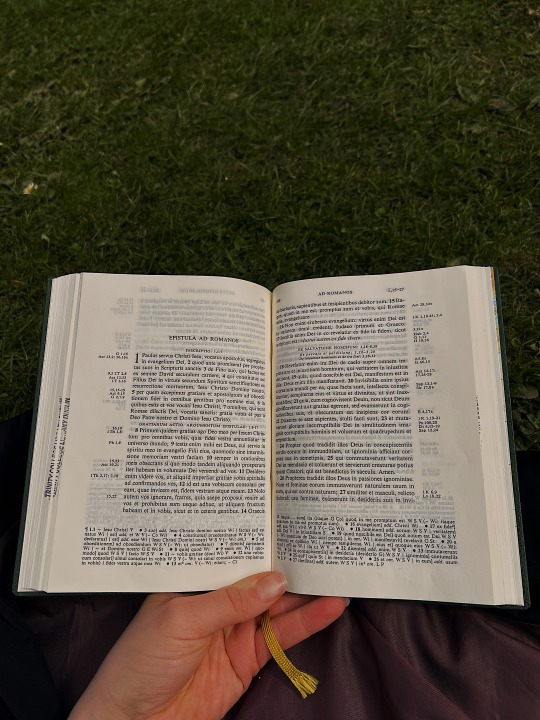

Day 1/100: Nova Vulgata ❤️🔥
So I did not as much forget about this account as I found myself overwhelmed by the most meaningless occurrences and activities and neglected this... that being said, hello again. I have not forgotten you!
I decided to start the '100 days of productivity' posting challenge with the high hopes it will give me both motivation and accountability in my studies, especially as I am now more determined than ever before to really, really succeed. Here's how my first day went:
I am reading the Nova Vulgata or the Latin Bible used by the Catholic Church and academics alike. The edition I'm currently perusing is the Nestle-Aland Novum Testamentum Latine, which I found in my university's library. The issue with my Latin is that I get the gist of what I read, but am completely lost when it comes to individual words and their variations, or, worse even, verb tenses! Which means I'm terrible at direct translation! This really does not help me with my bible polyglottism skills... So my idea is that I will learn words I don't yet know by reading the (New Testament) Bible (a collection of texts I am familiar with) in Latin and checking words and passages I cannot crack in my English translation! That will not teach me grammar or sentence structures, but I can at least be more familiar with the language as it stands in the biblical context. (Do not ask me about my Hebrew or Greek skills, I refuse to answer...)
Decided on a question I will answer for my final theology essay of the year. So exciting! I do hope I answer it competently, as I both want my fix of academic validation as well as to surpass my current essay writing and, more importantly, research abilities.
Overall, not a bad day, but not my most productive by far. Just glad I am finally interacting with biblical languages again (modern language slumber moment)! I do hope to get stuff done this week, as the academic year is coming to a close, and I have so much to do still! I love how enjoyable life is these days (and every day, really. I'm an extraordinarily content individual).
Today's stats:
🎧 - Mozart: Requiem in D Minor, K.626 - 3a. Sequientia: Dies irae
📖 - Viktor E. Frankl: Man's Search For Meaning
Daily weather: ☀️Sunny and warm! (although it did rain a teensy bit in the morning).
(PS: the list of tags is gigantic and absurd but I am trying so hard to find like-minded individuals on the hellsite so bear with me!)
#studyblr#studying#studyspo#study inspo#study motivation#book#reading#100 days of productivity#100 days of studying#productive#academia#light academia#light academia aesthetics#university studyblr#dark academia#biblical studies aesthetic#biblical scholar#undergrad student#undergraduate#nova vulgata#Novum Testamentum Latine#latin student#new testament#dark academism#religious dark academia#religious academia#donna tartt#dark academia aesthetic#theology
18 notes
·
View notes
Note
omg spanish translations?? which ones do you recommend :0
Apologies for the small delay of this ask, I was returning home. ANYWAYS this is a topic that I control a bit more.
The sad part, tho, it's that all of these are old, old as hell. Sadly classics haven't been very important nowadays for Spanish-speaking scholars, unless they're from Ancient Rome, so :/
MY ABSOLUTE FAVOURITE because it doesn't add random things and stays loyal to the original text is from Germán Gómez de la Mata. The editorial is La Esfera de Los Libros. It's an Spanish translation from a French translation, tho, but it really follows the original text ! It doesn't demonize Odysseus, but it doesn't ignore his mistakes either, it's my favourite to re-read :)
The one from the editorial GREDOS is said to be pretty good, and the one that can be found online. It's... Again, a translation from a translation, not from Greek to Spanish. If I remember correctly, it's from French to Spanish again. This happens a lot in Spanish translations so 💀
This is the favourite one by far from the rest of the people, but not mine. It is the translation done by Luis Segalá y Estalella. There's some details that I would fix, but in general, thankfully, it's pretty accurate to the original text. The editorial is LIBRERO. The reason it's so liked besides having some mistakes that make you go ¿🤨? it's because it's translated from Greek to Spanish. But that, kind of makes it worse, since if it's translated DIRECTLY from the original language, why do you add things that weren't in the text?
Those are the best ones that I can recommend. I have more editions of the Odyssey, but they're not as good. Hope this helps, in any case !
5 notes
·
View notes
Text
The Ego of a Mouse: The Poetry of Homer
Note on the text: I used Poems from Greek Antiquity as edited by Paul Quarrie and published by Everyman Library in 2020.
Batrachomyomachia is a really funny short poem that is meant to be a parody of the Homeric epic style. In fact Homer, who wrote The Iliad and the Odyssey, is one of the proposed authors of this text although this has never been irrefutably proven.
In this poem, a frog comes to a watering hole and asks the mouse that he sees there who he is. The mouse answers in a gloriously hubristic, hilariously funny, ridiculously long, monologue that successfully lampoons the “epic” Homeric style. It is also a not so subtle jab at the ego of man- at how we keep assuming that we are the most powerful creatures in the universe despite not even being the most powerful creatures on this planet. Our ability to consistently prop ourselves up, to argue that we are the pinnacle of creation is slightly ridiculous. And for what it’s worth Batrachomyomachia is a Greek word that actually means a trivial altercation:
Known to the gods, the men, the birds that fly/ thro’ wild expanses of the midway sky,/ my name resounds; and if unknown to thee,/ the soul of great Crumbsnatcher lives in me./ Of brave Breadwinner’s line, whose sleeply down/ in love compress’d Lickporridgebowl the Brown./ My mother she and princess of the plains,/ where her father Bacongobbler reigns:/ Born where a Cabin lifts its airy shield,/ with figs and nuts, with vary’d dainties fed./ But since our natures nought in common know,/ from what foundation can a friendship grow?/ These curling waters o’er thy palace roll;/ But Man’s high food supports my princely soul./In vain circled loaves attempt to lie/ conceal’d in flaskets from my curious eye./ In vain the tripe that boasts the whitest hue,/ in vain the gilded bacon shuns my view,/ in vain the cheeses, offspring of the Pale,/ or honey’d cakes to which the gods themselves regale./ And as in arts I shine, in arms I fight,/ mix’d with the bravest and unknown to flight./ Tho’ large to me the human form appear,/ not Man himself can smite my soul with fear./ Sly to the bed with silent steps I go,/attempt his finger or attack his toe,/ and fix indented wounds with dext’rous skill./ Sleeping he feels, and only seems to feel./ Yet we have foes with direful danger cause,/ grim owls with talons arm’d and cats with claws,/ and that false trap, the den of silent Fate,/ where death his ambush plants around the bait;/ all dreaded these, and dreadful o’er the rest/ the potent warriors of the Tabby vest,/ if to the dark we fly, the dark they trace,/ and rend our heroes of the nibling race (30-31).
I love the way that this mouse really does sound like he is one of the Greek heroes of old. The way that he talks about his lineage, the enemies that he has faced, the dangers that he has overcome, you’d think he was Achilles. Hilarious.
5 notes
·
View notes
Text
Sonnets from Marcus Aurelius 1
Much like the poems by Ellis Walker on Epictetus, I came across these sonnets by James Vila Blake on Marcus Aurelius quite by accident. This time, in search of poetry with a Stoic character, I found them scanned in an obscure corner of the internet, the digital equivalent of a dusty shelf in a back room, and I have yet to hold a physical copy in my hands. Though I have always preferred the feel of real paper, this version will surely do for the moment.
I had never heard of the author before, and a bit of digging revealed that James Vila Blake (1842-1925) was a Unitarian minister, best known for his essays, sermons, and as an editor of hymns. Though I am largely unfamiliar with the Unitarian tradition, I was quite taken by his words on the mission of his church:
Love is the spirit of this church,
and service is its law.
This is our great covenant:
To dwell together in peace,
to seek the truth in love,
and to help one another.
Beyond all our theological bickering, it would be nice if more of us could hold to such basic principles.
In his foreword, Rev. Blake explains how he came to write these poems, so I will only add how happy I was to see someone taking the time to reflect on the writings of Marcus Aurelius with such reverence and affection. If I had a gift for verse, I would attempt something similar, as a sort of homage, but I can only manage my cumbersome reflections.
There are 31 sonnets here, each working from a specific passage in the Meditations, plus a proem and and epode. Blake includes these sections of the original text before the poems, both in the Greek and his own translation.
Now while my Latin has become passable over the years, I have sadly never been able to move beyond the most rudimentary grammar and vocabulary for Greek, and so I cannot make any judgments about the quotations I see here. For the sake of completeness, I have included the Greek as it appears in the scan, fixing only the most obvious typos, and I have left the rest as it is.
If you happen to have any talent in Greek, and you find glaring mistakes, which are quite likely in such a transcription, I would encourage you to embrace the task of a thorough edit. I'm sure a proper academic could do this in very little time, by comparing the Blake copy to a scholarly edition. Your effort would be of great help in keeping this fine work alive!
—3/2010
* * * * *
Sonnets from Marcus Aurelius
James Vila Blake
THOS. P. HALPIN COMPANY, CHICAGO, ILLINOIS
Copyright by JAMES VILA BLAKE, 1920
TO THE Rev. A. W. OXFORD, M. O. LONDON, ENGLAND
FOREWORD
When I had read the book of Marcus Aurelius many times, and was reading it after a long interval once again, which was also in company and aloud, I noticed the worthy matter for poetic treatment presented by the great Emperor’s noblest and most characteristic sayings. I marked such passages, and they remained for many years marked and no more.
Then I remembered them, recurred to them, and found my former impression confirmed. Hence these heroic hymns, as perhaps I may call them, the sonnet appearing to me the poetic form most suitable and germane. Do or can the lofty thoughts herein versed, gain from verse? The reader must judge, and possibly the fortunes of the present recital may afford some indication whether the stern and high terseness of the original can profit by the expansion, diction and imagery of verse.
Certainly in clarity, no; but in persuasiveness, possibly yes. The question seems much like a query whether excellent drawing in ink can gain by brush and color. What is proper matter for poesy, is a question belonging to poetic technics, and there is wide space and a thousand species between a geometrical demonstration or a bit of chemical nomenclature, and the heroics of a ballad; but at first blush perhaps it may be surmised that whatever thought is big enough and humane enough, may lay all Nature under contribution, and need not disdain the warrant of poetic fancy, trope, form or diction.
As to the diction, for aught that appears, the word rondure which Shakespeare liked, is as good as roundness, or sphericity, or circularity, or curve, or curvature, or concavity, or convexity, or circumbendibus, and if this be granted, poetic language scores a point perhaps, though I have known poets and others look askance at “rondure.”
The Greek and a prose rendering are placed together, and the sonnet opposite them. In the rendering I have not sought to give a literal transcription of the original, but rather the embosomed spirit and redolence of it. But it may be hoped this will be acceptable, since for those who might disapprove the Greek is added.
The text is accepted from “The Communings with Himself of Marcus Aurelius Antoninus, Emperor of Rome, together with his Speeches and Sayings. A Revised Text and a Translation into English, by C. R. Haines, M.A.,, F.S.A. London, William Heinemann. New York, G. P. Putnam’s Sons.”
—J. V. B.
The Greek excerpts are taken by means of a photo-etching process. Of course the result would have been more elegant if I had employed a Greek compositor; but the virtue of the text is not affected, and J have done what I could under the conditions.
* * * * *
PROEM
Marcus, thy stoic wit lacks naught in-door;
Out-door methinks thou shouldst be more at play,
Hill, vale, wood, brook, be fellows by thy way,
And wider wanderings on the sea-green shore.
Thou shouldst a stilly meadow pool explore
For doubled lustres of the early day,
Or soft reflections of capacious gray
That hath the meadow’s verdure tented o’er.
O if a rose had trembled to thy kiss
More than some culprit quailed before thy power,
Mayhap I had not now been writing this,
Thou being too great to gain thy day and hour.
Well, well, wide soul thou wert, kind heart, mind’s dower,
And to thee I am pious and submiss.
* * * * *
1.
Εωθεν προλέγειν ἑαυτῷ: συντεύξομαι περιἔργῳ, ἀχαρίστῳ, ὑβριστῇ, δολερῷ, βασκάνῳ, ἀκοινωνήτῳ. πάντα ταῦτα συμβέβηκεν ἐκείνοις παρὰ τὴν ἄγνοιαν τῶν ἀγαθῶν καὶ κακῶν. ἐγὼ δὲ τεθεωρηκὼς τὴν φύσιν τοῦ ἀγαθοῦ, ὅτι καλόν, καὶ τοῦ κακοῦ, ὅτι αἰσχρόν, καὶ τὴν αὐτοῦ τοῦ ἁμαρτάνοντος φύσιν, ὅτε μοι συγγενής, οὐχὶ αἵματος ἣ σπέρματος τοῦ αὐτοῦ, ἀλλὰ νοῦ καὶ θείας ἀπομοίρας μέτοχος, οὔτε βλαβῆναι ὑπό τινος αὐτῶν δύναμαι: αἰσχρῷ γάρ με οὐδεὶς περιβαλεῖ: οὔτε ὀργίζεσθαι τῷ συγγενεῖ δύναμαι οὔτε ἀπέχθεσθαι αὐτῷ.
At early morning warn yourself thus: Today I shall happen on busy-bodies, ungrateful fellows, insolent boors, deceitful plotters, spiteful churls, unkind neighbors. All these ills have befallen them by reason of their ignorance of good and evil. But I have understood the nature of the good, that it is beautiful, and of the evil, that it is ugly, and of the ill-behaved man himself, that he is of the same source, kith and kin, with me—not of the same blood and flesh, but sharing in reason and a divine part; for which cause I neither can be injured by any one of them (since no one can wrap me up in baseness) nor can I be angry or hold bitter feeling against this kinsman of mine.
—Marcus Aurelius, Meditations 2.1
1.
When the sun riseth, consider what he sees,
And tell thyself that surely through the day
Thou shalt see like the sun. Not hills, and trees
On them, green meads, kine grazing, lambs at play,
Soft clouds, and birds sipping at brooks—not these
I mean, albeit they sparkle wide away;
But surly men, churls, fops at insolent ease,
The gossip, knaves that envy, steal, betray.
But what! If so they be, be so must I?
Or to do like them, is that arms to meet them?
So hapless they in sense, ’tis mine to ply
My wisdom for them, not flout or ill-entreat them.
Fine wit ’s most dowered, and hath his best estate,
When civil most to wits less fortunate.
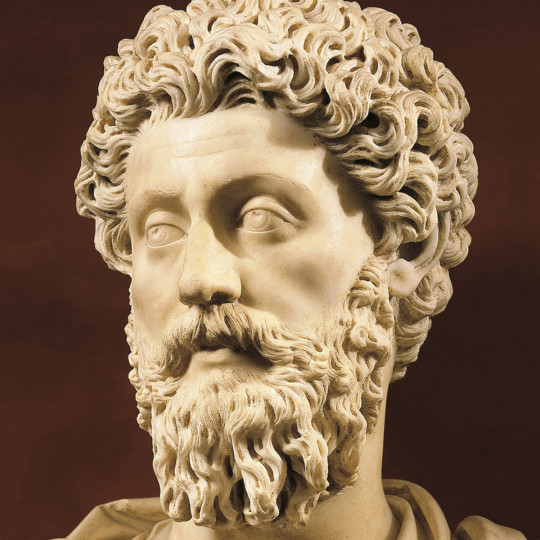
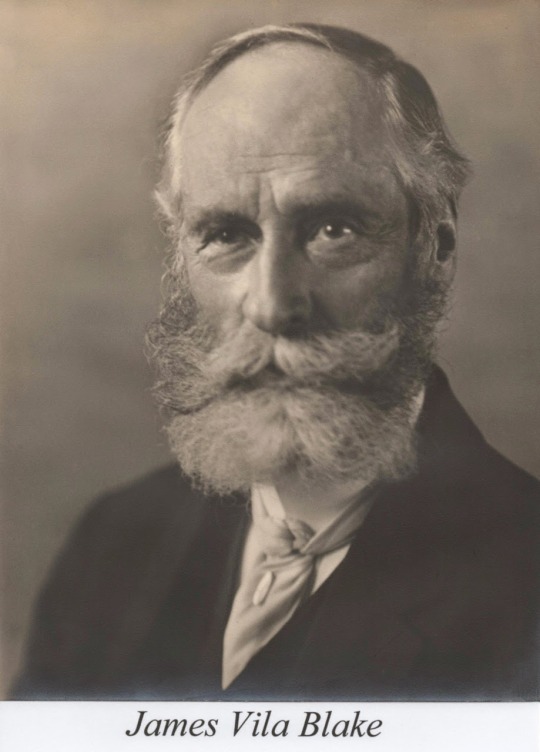
2 notes
·
View notes
Text
Title: Cunning Linguists
Author: Victoria McArthur
Rating: 5/5 stars
This is a book on a topic that has always piqued my curiosity but which I rarely get time to explore. I like libraries -- and there are lots of them in this book. (Not quite enough: it seems as though some of my favorite books could have filled in one of those missing gaps.)
It is an unusual book, in that it is a self-contained historical study (so far as I can tell) that has only one main thesis: the linguistic history of a set of concepts, many of which are common across a wide range of times and places.
The book's main character is the concept of literacy. The book opens by telling us in a brisk and informative manner how literacy spread across Western Europe from the Middle Ages onward. It tells us how one of the main channels for this process, the vernacular Bible, came to be, and how the Bible itself was first translated into a vernacular from Latin into a vernacular from French. It tells us that all this is part of a long and continuous history, involving the adoption and adaptation of new cultural practices, often under the influence of other forces.
But the book goes on to treat the concept of literacy as such an object of study. It tells us to stop and think, for example, about whether different words are used for the same things, or for similar things, or for things with different, but comparable, properties. It tells us to think about concepts like "reading" and "writing," and the ways in which they might vary across time or space, and how these variations might have influenced the concepts and practices involved.
And it does so, in a book-length volume, with a hundred pages or so per chapter, mostly with no footnotes or references (unlike the kind of book I am used to), and many of those pages devoted to illuminating some small corner of the territory. Reading such a book demands a certain persistence of attention. At the very least I had to keep reminding myself to turn pages in a linear fashion, instead of taking a break and reading something else in the meantime.
Of course, the topic is not just about words. The Bible, and literacy, are only a part of the story; we also read other texts that have only one thing in common with each other but that share some common features with the Bible or with each other. There are texts in Arabic, for example, which are known to us as works of science. And not just science -- in one of these texts, Al-Biruni cites a passage of Arabic poetry (probably not by Ibn Sina but not by any of the more obscure poets anyway). Another one describes a "truly strange and wonderful" comet. Another treats of how the moon waxes and wanes during the year. Al-Biruni (I am reading in my edition) uses the word "waxing," which appears to be based on the idea of cycles of moon-growth and moon-decay. The passage I read is cited alongside one that describes the phases of the moon (in the original language, the Latin of an earlier version of the work), and again, the language of the passage is cited in full in an appendix. It might just be a coincidence that the English word "phases" seems to have arisen from the Greek phasis, but the wikipedia article for it has the comment that
"At the same time, the Ptolemaic epicycles were added to models of the Solar System and planetary orbits. The idea of fixed stars and planets, and their epicycles, made planetary models in accordance with ancient Greek epicycles, which in turn were derived from the Democritus theory of the planets as moving masses, and the Pythagoreans' belief in the rotundity of the earth."
5 notes
·
View notes
Text
A brief update on my Classics studies. In my Latin studies in 2022 I am working my way through Lingua Latina Per Se Illustrata and am nearing the far edge of the middle of Pars I. I can reasonably recognize and parse sentences in present and future tenses in the indicative mood and active voice and recognize other moods and tenses correctly about 65 to 70 percent of the time. Probably using those words incorrectly but idc too much right now. I’ll fix that later. In 1898 I am using Robert Leighton’s Latin Lessons in conjunction with Allen and Greenough’s New Latin Grammar (about 5 years too early to be using the New Latin Grammar - first published in 1903 - but I really couldn’t be arsed to bind my own copy of an earlier edition and I couldn’t find a reasonably decent antique copy online of any earlier edition). I supplement with various readers while in character.
For Greek in 2022 I go between the JACT’s Reading Greek books and Hansen & Quinn’s Greek: An Intensive Course, only because I want the more compact exercises in H&Q sometimes and sometimes I just want to read something comprehensible. In 1898 I am working my way through John Williams White’s First Greek Lessons in conjunction with Goodwin’s 1892 expanded Greek Grammar. I chose White’s lesson book because I like the structure and I found an answer key for it that was published in the 1880s so I can have both the textbook and key out and around at the village. White’s text and key I printed and bound myself and I must say I’m rather proud of them, though the cover I placed on the text is anachronistic (it’s about 30 years too late for wrappers like the one I constructed to be used on a textbook, but I wanted to do it and it matches the cover I put on the key quite nicely). I am making nice progress with vocabulary and grammar in Greek, a touch faster than I expected to. I can easily produce simple constructions in the indicative mood in the present, imperfect, and future tenses as well as first and second declension nouns and third on occasion when my brain decides it will work. I will say that the sheer existence of The Article makes life much, much easier in Greek - at least for me.
In any case, I am thoroughly enjoying the study and eagerly await when it will actually get difficult. Right now it all is very much memorizing constructions which is less difficulty and more just…like…tedium isn’t the right word but it has a similar weight. Idk. I’m not regretting this project yet which is the important thing, and the syntax study is I think helping my Japanese studies, too, which is weird but welcomed.
2 notes
·
View notes
Text
COMPOSITING HOMEWORK
FIRST IMAGE: GREEK GOD FROM JASON AND THE ARGONAUHTS

Firstly, placing the image down in the project, and giving it an overlay of itself so I can see what I'm adding/erasing.
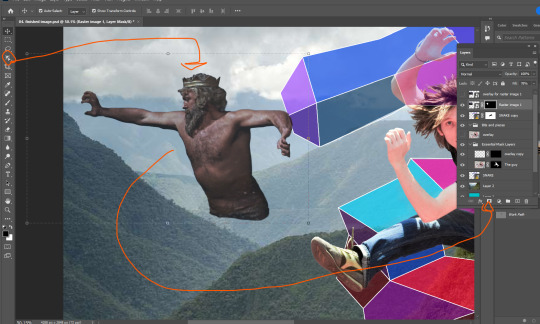
Here, using the easiest tool first. The Object Selection Tool to get a simple outline of the God, then turning it into a selection using the Work Path (alt + click on the box beside the Work Path text). After that, we just make a mask of the selection.

I want him back behind these hills. That'll involve erasing some of him so he isn't in front of the hill.

Here I've moved him behind the hill, and also behind the vector snake. But I've got some edges to smooth out.

I've cleaned up a lot of those lines using the soft brush brush tool, making the lines less defined makes it so he looks further back in the image. I also lowered the opacity of the God layer, just to make him look further back.
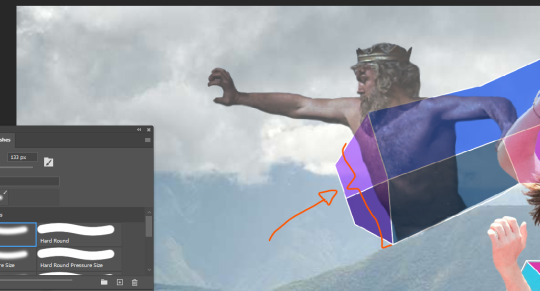
I felt the parts of the God's body behind the vector snake were too present, so I went in with the brush tool at about 3 transparency and made those parts more transparent.
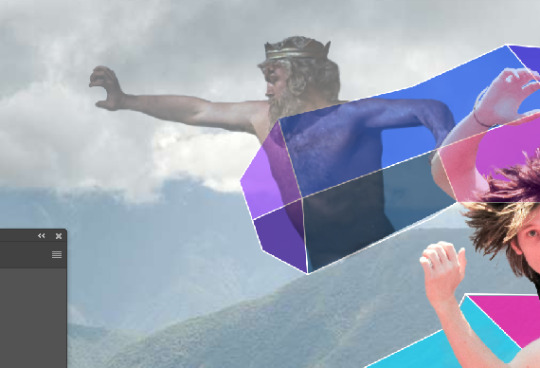
Decreasing the opacity of this layer again, just makes him look like he's right back.

I went in with a small brush as to fix up the weird hand as a result of him holding onto a rock in the original image.
SECOND IMAGE: RINGO

Next I wanted to try and incorporate a small image into my work, so I decided that RINGO STARR would be a funny guy to place in. I went for this black/white photo to place, mainly because I wanted to try and incorporate that into the composition.

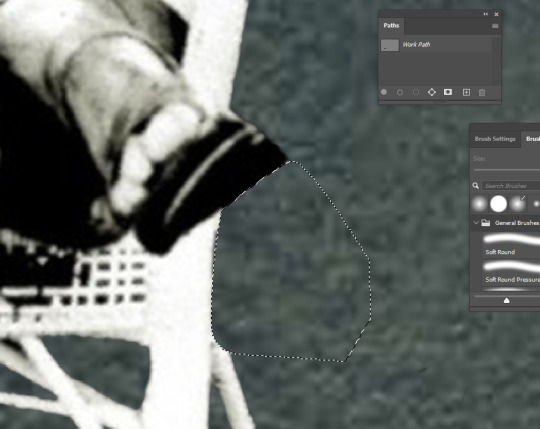
Pretty much applying the same formula I did with the Greek God, using the object selection tool to take Ringo and his chair out. The trouble is these small bits around here, so I just used the Pen tool to draw around this parts and then converted that into a selection, and filled that selection with black pixels on the mask layer.

The trouble now is how to hide that cut foot.

So I just placed him behind this bush, more specifically I removed his leg so it looks that way.

There he is, right in the back, looking on.
VECTOR IMAGE ONE: THUNDER

Unfortunately I forgot to document the creation of this file, but I made sure to open the whole photoshop image in illustrator (flattened), found where I want my thunderbolt, took an outline of it (the yellow squiggle), and then saved the file to this IMG folder. Making sure to keep it in that IMG folder.



Next, going into file and then place linked, just going to place that squiggle in place, then I can start editing it. Not skipping out on changing that setting circled in red to Media Box.

Here I'm taking a very similar approach to how I made the other vector image, but now I can explain it. First, I make two more layers, the top most layer being this white skeleton that outlines the bolt, and then a second layer for the colouring of the body. Also adding this gray background to make life easier in seeing the skeleton, but make sure to have that invisible when I save.

Then I go in and diversify the colours.
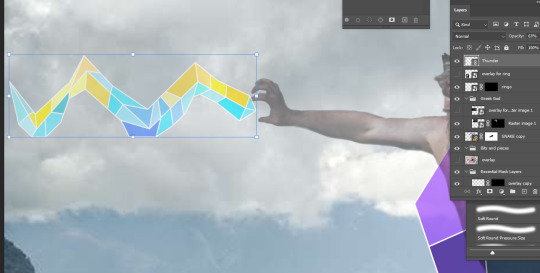
Here it is.

Making sure to place this bolt under the Greek God layer, I now go in and clean it up by creating a mask, and erasing all overlap with the hand (due to the transparency of the Greek God layer).

There it is.
VECTOR IMAGE TWO: Simple S
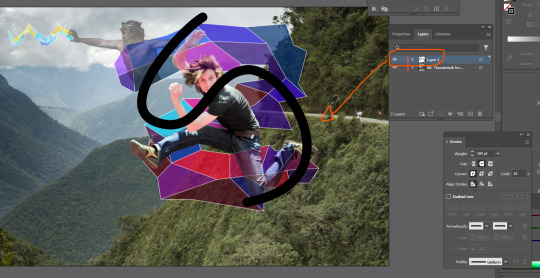
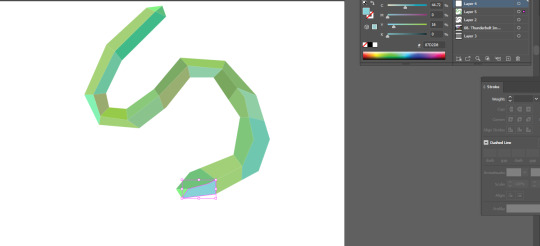
Pretty much following ever step as the previous vector object. I wanted to add another S behind the original, not sure why but I thought it'd look cool.

I need to add some more transparency to the Greek God as two layers are now overlapping him.

Just going in with the transparency turned to about 3 and a soft brush to lighten this pare up a little.

Finally complete, the full image.
Reflection:
I definitely stressed a lot while making this, and also cutting it close to the deadline doesn't help (just struggling to manage time at the moment). I completely forgot about the skeleton/body method when it came to making vector objects, so just went back and inspected the first one I made for this image. So, I wish I documented that process originally. This definitely helped build my skills, but it also stressed me the hell out, but that's life I suppose.
ALSO AN EXPLAINATION FOR WHY ALL THE IMAGES HAVE A GOOGLE LINK: I found Tumblr to be an annoying way to store screenshots, so I just chucked them into a google doc, turns out taking those images from the doc and placing them in links them as an image from google drive, I'll make sure not to do that again as it kinda annoys me.
here's the doc link: https://docs.google.com/document/d/1LazwekuUFVEyU9cOZBdAik50wVuxgqdyPpAmv9W9FjM/edit?usp=sharing
0 notes
Text

zip's tid bits | saturday, 11/04/23
( ) accidentally fell asleep real early last night & woke up at 5:30am
(-) got mixed up on the time and didn't get to do my full morning routine before work
(+) worked 8am - 12pm (and saw a dog being carried like a baby & got a lot of academic tasks done)
(-) friend asked to bribg her cousin to my bday dinner and i felt like i had to say yes even though i didn't want that
(-) kept feeling sick to my stomach (i think it was anxiety & stress but i couldn't figure out what was making me feel that way ;-;)
(+) had soup for lunch!
(-) friend who invited her cousin made us super late to dinner so we had a huge wait
(+) caught up with my friends and honestly this was the first time i didn't feel like our friendship was ending as we were hanging
(+) played a little star trek: online bc i was craving character creator :)
overall: good day!
key takeaways: friendships aren't worth the small irritations, soup fixes all <3
the to-do list:
(✔️) leave feedback on example report
() edit statement of purpose
(✔️) 2pgs of lecture notes
(✔️) read 2pgs of article
(✔️) plan research tasks for next week
(✔️) tend to plants - water & plant cutting
(✔️) fold laundry
(✔️) clean room - tidy, vacuum, & mop
(✔️) clean shoes
(✔️) text mom & email grandpa
() dulingo - spanish & greek
() buy myself a bday gift (minecraft lego!)
routine tracker:
morning routine: 7/12
night routine: ?/17 -- tbd
habit tracker:
?/13 habits completed -- tbd
image credit :)
#me finally being able to see the floor of my room is my bug birthday gift to myself <3#also i'm kind of :( that i didn't manage to get myself the gift yet :(#new goal is tomorrow!!!#described in alt text#(<- idk if i'm any good with that so feedback is welcome)#studyblr#studyspo#uniblr#zip's tid bits
0 notes
Text
SmartOffice Doc & PDF Editor Mod Apk Free Download version 3.13.10
SmartOffice Doc & PDF Editor Mod Apk
editing application designed to meet the needs of today's mobile world. View, edit, create, present & share MS Office documents directly on your mobile devices. Use our safe and secure direct download your SmartOffice Doc unlimited money master mod latest version premium free & PDF Editor Mod Apk
SmartOffice Doc & PDF Editor Mod Apk
WHAT'S NEW
•One-Drive support
•Dark Mode Content support
•Footnote & Endnote editing (Docx)
•PDF Redactions (PRO feature)
•Numerous bug fixes & performance enhancements
SmartOffice Doc & PDF Editor Free Download
FREEDOM TO WORK ANYWHERE
•DOCUMENTS: Create new using blank or pre-designed templates
•PRESENTATIONS: View, edit & present slideshows
•SPREADSHEETS: Review and edit budgets, expense reports,s and more
•PDF: View, annotate, & convert Office documents to PDF
•PRINT: Wirelessly to thousands of supported printers, including AirPrint
SmartOffice Doc & PDF Editor Unlimited Money
COMMON FEATURES ACROSS ALL FORMATS
•View, edit, create, share, save & print MS Office documents quickly and securely
•Editing: Copy, cut, paste, undo & redo
SmartOffice Doc & PDF Editor latest version
•Character Formatting: Bold, italics, underline; font style, size, color & highlight
•Documents may be saved in their original file format or converted to PDF
•Pre-designed templates to aid new document creation
SmartOffice Doc & PDF Editor premium free
•Password Protection Support (Office x files): Open, view, edit, & re-save encrypted documents on your device
•Cloud support: Open & save documents to the cloud with effortless synchronization with Box, Dropbox, Google Drive & OneDrive
•Full-screen viewing mode
•Dark mode content support
SmartOffice Doc & PDF Editor master mod
DOCUMENTS
•Indent, align, bullets, numbering
•Insert images, shapes, graphics
•Support for tables, shapes, charts (display)
•Reflow mode for easier reading on a small device
•Edit footnotes and endnotes (Docx)
SmartOffice Doc & PDF Editor Mod Apk pro apk
PRESENTATIONS
•Text, paragraph, & content formatting
•Insert images, shapes, and graphics
•Slide management & reordering
•Slide transition support
•Present directly from your mobile device or through a projector
PDF
•View, annotate, highlight and share PDF documents
•Convert, export, and save Office documents to PDF format
SmartOffice Doc & PDF Editor apk version
UPGRADE TO PRO
•Track Changes – Collaborate, exchange edits & comments in a shared doc file
-Configure multiple authors
-Navigate previous/next changes
-Accept/reject changes from other authors
SmartOffice Doc & PDF Editor unlimited version
-Edit existing changes
•PDF Form Filling – Supports PDF AcroForms
-Fill, view, save & share form content.
-SmartOffice PRO offers limited support for XFA forms
•PDF Redactions – Supports PDF AcroForms
SmartOffice Doc & PDF Editor master mod
LANGUAGES
∗Localized for: Chinese (Simplified/Traditional), English, Japanese, French, German, Italian, Korean, Polish, Portuguese (Portugal/Brazil), Russian, Spanish (Spain/Mexico), Hebrew, Dutch and Turkish
∗View: Arabic, Azerbaijani, Chinese (Simplified),
SmartOffice Doc & PDF Editor pro apk
Chinese (Traditional), Czech, Danish, Dutch, English, Faroese, Finnish, Greek, Georgian, Hebrew, Hungarian, Italian, Japanese, Korean, Kurdish, Latvian, Lithuanian, Maltese, Norwegian, Polish, Portuguese (Portugal/Brazil), Russian, Scots Gaelic, Slovak, Slovenian, Spanish (Spain/Mexico), Swedish, Turkish, Vietnamese and Yiddish
Permission
Showing permissions for all versions of this app
This app has access to:
contactsContacts
find accounts on the device
Photos/Media/Files
read the contents of your USB storage
modify or delete the contents of your USB storage
Storage
read the contents of your USB storage
modify or delete the contents of your USB storage
Identity
find accounts on the device
Other
view network connections
full network access
prevent the device from sleeping
Updates to SmartOffice - Doc & PDF Editor may automatically add additional capabilities within each group.
How to SmartOffice Doc & PDF Editor Install
Install the steps:
Download SmartOffice Doc & PDF Editor Mod APK on our site.
After completing the download, you must find the apk file and install it.
You must enable "Unknown sources" to install applications outside the Play Store.
Then you can open and enjoy the SmartOffice Doc & PDF Editor Mod APK
Is SmartOffice Doc & PDF Editor Mod Safe?
SmartOffice Doc & PDF Editor Mod is 100% safe because the application was scanned by our Anti-Malware platform and no viruses were detected. The antivirus platform includes AOL Active Virus Shield, avast!, AVG, Clam AntiVirus, etc. Our anti-malware engine filters applications and classifies them according to our parameters. Therefore, it is 100% safe to install SmartOffice Doc & PDF Editor Mod APK on our site.
You May Also Like: Art of War Legions Mod Apk
More Info: Google Play
What’s New
Adjustments to Techs and Facilities
– The effects of the techs “Break the Limit”, “Beyond the Limit” and “Reach the Limit”
respectively.
– The highest quality of a Hero will be Legendary 3-Star.
– Raised the CP of some techs.
– Adjusted the CP of some facilities and the resources and time required in their upgrading
Here you can download the latest version of Mod APK for free
Now: Use our safe and secure direct download link to download your SmartOffice Doc & PDF Editor Mod Apk Free Download version 3.13.10 Unlocked Version and enjoy the latest free version.
0 notes
Text
Notefile . ca

#Notefile . ca pro
#Notefile . ca free
#Notefile . ca mac
that its Admin Office and staff are located on the Mohawk Territory of Kahnaw:ke south of Montreal, Canada. Previously the hg19 version of the bed file was uploaded for the K562 H3K9me3 samples only. PLEASE NOTE: File must be in MS Word format. The fourth column of the bed file contains the actual 36 base read sequence. Reads were then aligned to the hg18 assembly using MAQ with default parameters.
#Notefile . ca mac
Our Mac app can show in your Dock or your menu bar, and it’s a compact window. Your notes sync automatically with iCloud, or our own Junecloud sync. It’s available as a Mac app, a Dashboard widget, and a universal app for iPhone, iPad, and iPod touch. Libraries were sequenced on the Genome Analyzer following the manufacturer's protocols.īed files: Any reads longer than 36 bases were first truncated to 36 bases. Notefile lets you make quick notes and view them easily, on all your devices. The purified DNA was captured on an Illumina flow cell for cluster generation. After IP and adapter ligation library fragments of ~250 bp were isolated. Chromatin was fixed and sheared to 200-600 bp using Branson Sonifer. It does not store any personal data.GEO help: Mouse over screen elements for information.ĭescribed in Mikkelsen et al., Nature 2007. The cookie is set by the GDPR Cookie Consent plugin and is used to store whether or not user has consented to the use of cookies. The cookie is used to store the user consent for the cookies in the category "Performance". This cookie is set by GDPR Cookie Consent plugin. The cookie is used to store the user consent for the cookies in the category "Other. The cookies is used to store the user consent for the cookies in the category "Necessary". The cookie is set by GDPR cookie consent to record the user consent for the cookies in the category "Functional". The cookie is used to store the user consent for the cookies in the category "Analytics". This cookie is set by GDPR Cookie Consent plugin. For the purposes of section 150, where a return of income of a taxpayer for a taxation year is filed by way of electronic filing, it shall be.Missing: notefile. These cookies ensure basic functionalities and security features of the website, anonymously. Necessary cookies are absolutely essential for the website to function properly. Click and hold Notefile 2.7 icon with your mouse button until it starts to wiggle. Open up Launchpad, and type Notefile 2.7 in the search box on the top.
Greek Language Guide & Audio – World Nomads Option 2: Delete Notefile 2.7 in the Launchpad.
(Unsupported versions for 32-bit Windows and 32-bit Linux environments will be also provided for those who cannot run 64-bit programs.) NOTEFILE gets an optional parameter indicating the file to be opened and edited. Note: File(s) limited to 1 MB size and certain file types (. NOTEFILE runs on 64-bit Microsoft Windows environments like Vista, 7, 8, 10, 11, etc.
Baja or Bust: By Mtn Dew & Motocross Elite To attach up to four (4) files to your question, use the Select button below.
These directories are created when I open text files, one directory per each file.
#Notefile . ca free
Oldies Music & Old Songs Free – 50s 60s 70s Radio Anyfile Notepad leaves 'Anyfile Notepad Files' directories in my Google Drive root directory.
Happy Birthday Emoji Stickers for iMessage.
#Notefile . ca pro
Power Nap App PRO – Best Napping Timer for Naps with Relaxing Sleep Sounds.
Bunny Shooter Christmas – a Free Game by the Best, Cool & Fun Games.
Skins For Minecraft PE – Minecraft Skins.

0 notes
Text
ok in my art history class we're doing a final project that are like group projects which from a teacher perspective and class perspective is WAY easier because you don't have to present each project one by one for all the people in the class. but anyways we're supposed to comment on other groups projects and one of them was so like straight up bad... like their topic was looking at the difference between ancient Greek ideals of perfection and modern day ones. and to show this they looked at... the architecture of dc. like one of if not the worst places to look at how a culture differs from ancient Greek culture literally. not to mention there was a very clear focus specifically on bodily perfection throughout the entire presentation like there was this gimmicks where there would be actors playing a modern instagram fitness couple and an ancient Greek athlete and they did different activities that showed how toxic modern fitness is. and like that's great but um why are we looking at buildings? like? we literally only looked at greek style buildings in dc and figurative ancient Greek statutes. what is going on. they didn't even look at a single statue in dc. there are statutes on the buildings. please. AND the editing was shit. the formatting was shit. the text? all over the place. what happened. it really seemed like there were two people who had very different understandings of what the topic was and what they were doing and they literally never discussed it. there's a comparison of the Supreme Court building and the Parthenon thrown in there randomly in the middle and they talk about the similarities between them and why... so random and never touched on again. the picture of the Parthenon is so tiny is like it's trying to hide.
sorry. i fucking love being negative. i was literally way nicer when i made my comment. but i was literally thinking like girl is shit like if you want to fix it you literally need to stay over...
1 note
·
View note
Photo


The Meaning of the Crucifix
A crucifix (from Latin cruci fixus meaning "(one) fixed to a cross") is an image of Jesus on the cross, as distinct from a bare cross. The representation of Jesus himself on the cross is referred to in English as the corpus (Latin for "body").
A crucifix often has the letters "INRI" carved into the wood of the cross. These letters are short for the Latin phrase, "Iesus Nazarenus, Rex Iudaeorum," which translates to "Jesus of Nazareth, King of the Jews."
These are the words which Pontius Pilate, the Roman governor of Judea who sentenced Jesus to death, ordered to be written on the cross on which Jesus Christ was crucified.
For Catholics, the figure of the suffering Jesus is present on the crucifix to symbolize Jesus' death as a powerful act of sacrifice to atone for the sins of the world, reconcile the relationship between God and humanity and make it possible for humans to enter into heaven.
Catholics embrace crucifixes as an intensely visible reminder that Christ Jesus suffered, died, and rose again for each one of us, every single individual human soul of the human race that ever was, is, or will be, and knew us all more than we know ourselves. Catholics emphasize both the crucifixion and the resurrection, not minimizing or downplaying the importance of either.
St. Paul emphasized the crucifixion saying, “When I came to you, brethren, I did not come proclaiming to you the testimony of God in lofty words or wisdom. For I decided to know nothing among you except Jesus Christ and Him crucified” (1 Cor 2:1-2). And in 1 Corinthians 1:18-24 He said, “For the word of the cross is folly to those who are perishing, but to us who are being saved it is the power of God. For Jews demand signs and Greeks seek wisdom, but we preach Christ crucified, a stumbling block to Jews and folly to Gentiles, but to those who are called, both Jews and Greeks, Christ is the power of God and the wisdom of God.” In Galatians 6:14 he proclaimed: “But far be it from me to glory except in the cross of our Lord Jesus Christ, by which the world has been crucified to me, and I to the world.”
Christ’s supreme act was to die on the cross as atonement for our sins. His resurrection was proof that what He did on the cross worked—He conquered death—and it demonstrated beyond any doubt that He was who He claimed to be: God. The crucifixion was the act that changed history. The resurrection demonstrated the efficacy of that act.
All text above is mashed together information from various sources, none of it belongs to me. Sources and Further reading under read-more
https://owlcation.com/humanities/catholic-symbols
https://en.wikipedia.org/wiki/Crucifix
https://www.catholic.org/news/hf/faith/story.php?id=56263
https://www.catholicfaithstore.com/daily-bread/embrace-crucifix-instead-plain-cross-whats-catholic/
https://www.catholic.com/magazine/print-edition/hope-of-the-human-race-victory-over-satan-cleansing-of-sin-the-open-door-to
https://www.catholic.com/encyclopedia/cross-and-crucifix-the
https://www.catholic.com/qa/why-do-churches-have-crucifixes-if-jesus-is-risen
https://www.catholic.com/qa/how-do-crucifixes-fit-in-with-the-old-testament-prohibition-of-graven-images
http://www.sttheresechurchalhambra.org/?DivisionID=19576&DepartmentID=28145
11 notes
·
View notes
Photo


THEME 06: GREEK TRAGEDY.
click the SOURCE LINK to access the code + preview!!
hello it’s me once again posting another theme. this one is once again made with character blogs in mind!!!!! i hope u like it!
THEME FEATURES.
361x692 side image
3 custom links
title and description
pagination located under description block
one-column
400px or 500px post size options
all colors can be changed
different text when words are italicized or bolded
GUIDELINES.
you can edit it to your liking but please don’t make it unrecognizable
do not remove credit
this is my first time editing my own themes so if there’s any issues, please let me know and i’ll try to fix them asap
please like or reblog if you use !!
if you’d like, you can support me by buying me a coffee or commissioning me. thank you and enjoy !!!!!!!
#mine: themes.#rp theme#simple theme#theme#themes#rph#hopefully this one works on mac laptops unlike my last one LMAO
304 notes
·
View notes